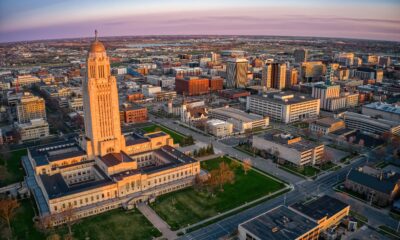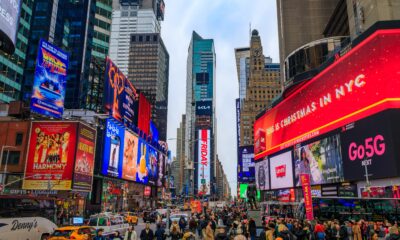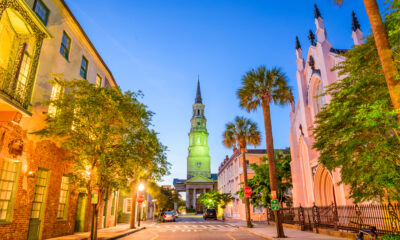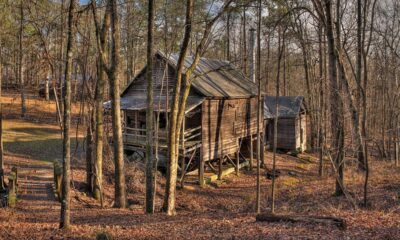Washington
From marshy parkland to Constitution Gardens: how Nixon erased his 1945 office
Published
3 weeks agoon

Nixon’s Journey from Navy Clerk to Presidential Demolisher
In 1945, a young Navy Lieutenant named Richard Nixon sat at a desk in Washington’s massive Munitions Building.
The 29-year-old legal officer spent his days negotiating aircraft contract terminations as World War II wound down. Nixon earned praise for his work, then moved on to bigger things.
Yet fate took an odd turn. In 1969, now as President, Nixon ordered the demolition of those same crumbling buildings where he once worked.
The marshy land was soon transformed into Constitution Gardens, where today you can stroll past the Vietnam Veterans Memorial near the spot where Nixon once shuffled papers.

Nixon Started His Government Career as a Tire Rationing Clerk
Richard Nixon moved from California to DC in January 1942 to work at the Office of Price Administration.
After practicing law in Whittier since graduating from Duke Law School in 1937, Nixon now handled wartime price controls.
He worked in the tire rationing division, answering letters from people about their rubber rations. This job gave the young lawyer his first taste of federal government work, starting him on the path to the White House.

The Young Lawyer Traded His Briefcase for a Naval Uniform
Nixon joined the Naval Reserve as Lieutenant (junior grade) on June 15, 1942. He could have used his Quaker background to avoid military service but chose to serve anyway.
By August 1942, he began flight training at Naval Air Station Quonset Point, Rhode Island.
After finishing training in October, the Navy sent him to the Naval Reserve Aviation Base in Ottumwa, Iowa as Aide to the Executive Officer.

The Pacific Islands Became Nixon’s Wartime Home
Nixon asked for sea duty in May 1943 and got it when the Navy sent him to the Pacific Fleet. He ran the South Pacific Combat Air Transport Command at Guadalcanal.
Later, the Navy moved him to Green Island during fighting in the Solomon Islands. His unit prepared paperwork for C-47 cargo planes that brought supplies to troops.
The Navy promoted Nixon to Lieutenant in October 1943 for his good work in the combat zone.

A Desk in the Massive Navy Headquarters Awaited His Return
Nixon came back to America in December 1944 after finishing his Pacific tour. Until March 1945, he worked at the Bureau of Aeronautics in the Navy Department in Washington DC.
His office sat in the Main Navy Building on Constitution Avenue, part of the same complex as the Munitions Building. The Navy used his law training for legal tasks.
The building complex held the Navy’s top leaders and served as the center of naval operations.

His Law Degree Made Him Perfect for Ending War Contracts
In March 1945, the Navy made Nixon the Bureau of Aeronautics Contracting Officer for Terminations.
He worked from the New York City office but traveled to Washington DC, Philadelphia, Buffalo, and East Hartford for his job.
Nixon handled the tricky task of ending wartime aircraft manufacturing contracts as the war slowed down. His legal know-how helped the Navy save millions of dollars as the country moved toward peace.

The Navy Commended Nixon as War Came to an End
Nixon celebrated Japan’s surrender with his wife Pat in Times Square in August 1945. The Secretary of the Navy gave him a second Letter of Commendation for his contract work.
The Navy promoted him to Lieutenant Commander in October 1945. By March 1946, the Navy let Nixon leave active duty after nearly four years of service.
His time in uniform taught him how the federal government worked and gave him useful knowledge about military contracts.

Poker Winnings Funded His First Political Campaign
Nixon won his first congressional election in 1946, beating incumbent Jerry Voorhis. He paid for his campaign partly with poker money he won during his Navy days.
The new congressman moved to Washington with his wife Pat and baby daughter Tricia. He got noticed while serving on the House Un-American Activities Committee looking into communists.
By 1950, Nixon won a U.S. Senate seat from California, and from 1953 to 1961, he served as Vice President under Eisenhower.

Those “Temporary” War Buildings Lasted Half a Century
The Main Navy and Munitions Buildings went up in 1918 as “temporary” World War I structures on the National Mall. By the late 1950s, they had serious problems, including cracked concrete, bent walls, and uneven floors.
Workers complained about the dampness caused by the marshy ground beneath.
In 1960, the Munitions Building housed 7,000 employees from various government departments.
Officials declared parts of the buildings unsafe in 1969, forcing about 3,000 employees to move elsewhere.

President Nixon Ordered the Demolition of His Former Workplace
Nixon became the 37th President in January 1969. By December that year, he announced plans to tear down the Main Navy and Munitions Buildings where he once worked as a naval officer.
The plan moved Navy employees to new buildings in Virginia. Nixon signed the demolition order for the buildings where he had spent months working on contracts.
The plan fit with his efforts to make the National Mall area more beautiful and park-like.

The Buildings Came Down as the Navy Band Played Farewell
Moving vans lined up in 1970 to relocate thousands of federal employees from the aging buildings. The Navy band played “Auld Lang Syne” as wrecking crews began tearing down the structures.
Crews reduced both massive buildings to rubble by the end of the year, ending their 52-year run.
The demolition closed the chapter on “temporary” World War structures that had become permanent fixtures on the National Mall.
Workers cleared the site to make way for the planned Constitution Gardens park development, transforming an eyesore into green space.

Nixon’s Old Office Became a Memorial Park and Vietnam Monument
The government dedicated Constitution Gardens in 1976 on the former site of the Navy and Munitions Buildings.
Designers created an artificial lake with an island memorial to the 56 signers of the Declaration of Independence. In 1982, workers built the Vietnam Veterans Memorial in the western section of Constitution Gardens.
The memorial stands near the exact spot where the Munitions Building once housed Nixon’s office.
In a twist of history, the site where a young naval officer once worked to end one war became a solemn memorial to those who served in another.

Visiting Constitution Gardens, Washington
Constitution Gardens at 1850 Constitution Avenue NW sits between the Vietnam Veterans Memorial and World War II Memorial, where Nixon once worked as a Navy officer before becoming the president who demolished those buildings.
You can visit this 36-acre park with its lake and walking paths anytime for free.
The Lockkeeper’s House has exhibits about the National Mall’s history, and you’ll find 56 granite blocks with gold signatures from the original thirteen states.
This article was created with AI assistance and human editing.
Read more from this brand:
John Ghost is a professional writer and SEO director. He graduated from Arizona State University with a BA in English (Writing, Rhetorics, and Literacies). As he prepares for graduate school to become an English professor, he writes weird fiction, plays his guitars, and enjoys spending time with his wife and daughters. He lives in the Valley of the Sun. Learn more about John on Muck Rack.


Here Are 12 Things People from West Virginia Do That Seem Insane To Everyone Else

Here Are 12 Things People from Washington Do That Seem Insane To Everyone Else

Here Are 12 Things People from Virginia Do That Seem Insane To Everyone Else

New Mexico Albuquerque International Balloon Fiesta wrap-ups and fall arts

Mississippi Natchez Trace fall festivals and music events

12 Reasons Why You Should Never Ever Move to Florida

Best national parks for a quiet September visit

In 1907, Congress forced Roosevelt to put God back on U.S. coins. Here’s why.

The radioactive secret White Sands kept from New Mexicans for 30 years

America’s most famous railroad photo erased 12,000 Chinese workers from history
Trending Posts

 Pennsylvania3 days ago
Pennsylvania3 days agoHere Are 12 Things People from Pennsylvania Do That Seem Insane To Everyone Else

 North Carolina4 days ago
North Carolina4 days agoHere Are 12 Things People from North Carolina Do That Seem Insane To Everyone Else

 Nebraska6 days ago
Nebraska6 days agoHere Are 12 Things People from Nebraska Do That Seem Insane To Everyone Else

 Maine5 days ago
Maine5 days agoThe ruins of a town that time forgot are resting in this Maine state park

 New York4 days ago
New York4 days agoHere Are 12 Things People from New York Do That Seem Insane To Everyone Else

 South Carolina2 days ago
South Carolina2 days agoHere Are 12 Things People from South Carolina Do That Seem Insane To Everyone Else

 Ohio4 days ago
Ohio4 days agoHere Are 12 Things People from Ohio Do That Seem Insane To Everyone Else

 Georgia5 days ago
Georgia5 days agoThis plantation’s slave quarters tell Georgia’s slowest freedom story
